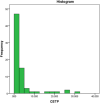Clinical, biochemical profile and atherosclerotic cardiovascular risk score (ASCVD) in patients with high HDL cholesterol
- PMID: 39920518
- PMCID: PMC12031829
- DOI: 10.1007/s11845-025-03878-8
Clinical, biochemical profile and atherosclerotic cardiovascular risk score (ASCVD) in patients with high HDL cholesterol
Abstract
Background: It was observed that many people in the western coastal belt were found to have a high HDL cholesterol, the cause of which was not known. This study was done to learn about the factors contributing to the high HDL cholesterol in these patients and its effect on ASCVD risk.
Methods: In this prospective, case control study, 150 patients were recruited, of which 63 were cases (patients with high HDL cholesterol), and 87 were controls (patients with normal HDL cholesterol). Details regarding their diet, sea-food consumption, habits, comorbidities, daily activity (using GPAQ questionnaire), and blood reports were collected. ASCVD risk score was calculated using an online ASCVD risk estimator. Blood samples of 96 patients (cases 40, controls 56) was tested for cholesterol esterase transfer protein (CETP) levels using ELISA, and the results were compared.
Results: Patients with high HDL cholesterol were found to be physically more active and had median metabolic equivalent (METs) of 4680 (1200, 8580) compared with controls with median METs of 1680 (720, 5580), P-0.013. Cases had a lower mean BMI 23.09(SD-3.69), than in patients with normal HDL cholesterol with a mean of 24.41(SD-4.01), P-0.04. Cases also had a lower triglyceride level (91(69,118) in cases vs 121 (80,151) in controls, P-0.002. Alcohol and sea food consumption had no role on HDL levels in this study. The median CETP level was lower in patients with high HDL levels, 0.336(0.08, 0.336) versus 1.435(0.061, 2.893) in the control group although not statistically significant. Patients with high HDL cholesterol were found to have a significantly lower median 10-year ASCVD risk score 3.05 (0.6, 8.95), compared with patients with normal HDL 6.45 (2.7,14.2).
Conclusion: Patients with high HDL cholesterol were found to be physically more active, had a lower BMI, a lower triglyceride level, and a lower ASCVD risk compared with controls. They also had a lower CETP level. Further research will be required to determine the normal CETP level in Indian population, their genetic makeup, and whether it has a role in cardiovascular protection.
Keywords: ASCVD; CETP; HDL cholesterol; Lipidology; METs.
© 2025. The Author(s).
Figures
References
-
- Rashid S, Sniderman A, Melone M et al (2015) Elevated cholesteryl ester transfer protein (CETP) activity, a major determinant of the atherogenic dyslipidemia, and atherosclerotic cardiovascular disease in South Asians. Eur J Prev Cardiol 22(4):468–77. Available from: https://academic.oup.com/eurjpc/article/22/4/468/5926591. [cited 2021 Nov 15] - PubMed
-
- Yokoyama S (2015) Unique features of high-density lipoproteins in the Japanese: in population and in genetic factors. Nutrients 7:2359–2381. [Internet]. 2015 Apr 2 [cited 2022 Dec 20];7(4):2359–81. Available from: https://www.mdpi.com/2072-6643/7/4/2359/htm - PMC - PubMed
-
- Carroll S, Dudfield M (2004) What is the relationship between exercise and metabolic abnormalities? A review of the metabolic syndrome. Sports Med 34(6):371–418. Available from: https://pubmed.ncbi.nlm.nih.gov/15157122/. [cited 2021 Dec 2] - PubMed
-
- Varady KA, Bhutani S, Klempel MC, Kroeger CM (2011) Comparison of effects of diet versus exercise weight loss regimens on LDL and HDL particle size in obese adults. Lipids Health Dis 10:119–119. Available from: https://www.ncbi.nlm.nih.gov/pmc/articles/pmid/21767400/?tool=EBI. [cited 2021 Nov 22] - PMC - PubMed
-
- Palazón-Bru A, Hernández-Lozano D, Gil-Guillén VF (2021) Which physical exercise interventions increase HDL-cholesterol levels? A systematic review of meta-analyses of randomized controlled trials. Sports Med 51(2):243–253 - PubMed
MeSH terms
Substances
LinkOut - more resources
Full Text Sources
Medical





